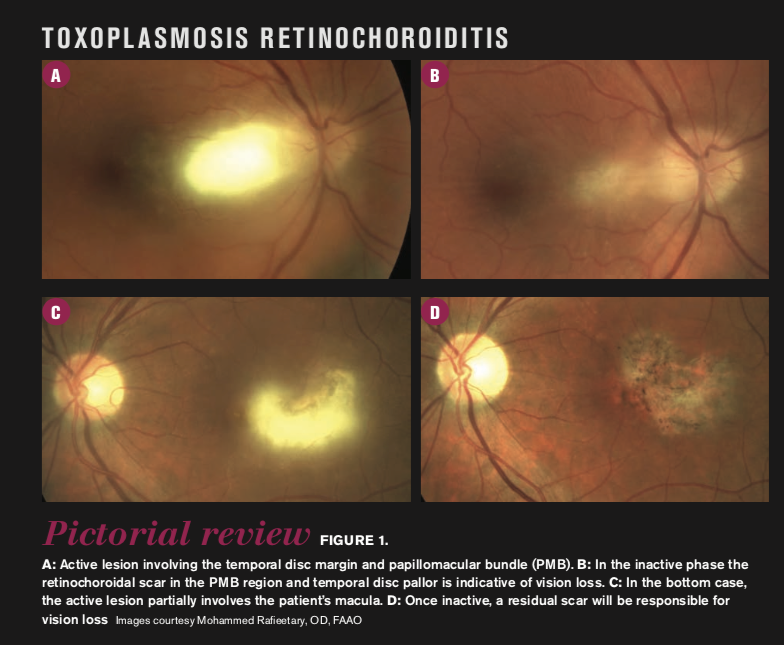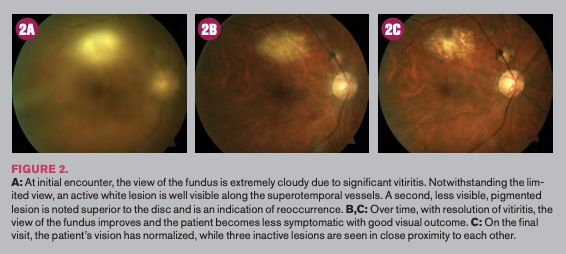Toxoplasmosis retinochoroiditis pictorial review
Knowing the clinical signs can aid diagnosis and treatment



Toxoplasmosis is considered the most frequent etiology for “infectious” retinitis or, more appropriately, retinochoroiditis.1 The rationale for the nomenclature is that the infection begins in the superficial or “inner” retina and works its way toward the deeper “outer” retina, and eventually the choroid.
The organism responsible, Toxoplasma gondii, is a single-cell, obligate, intracellular protozoan parasite. Although a number of mammals, birds, and reptiles serve as a host for this organism, cats are the most definitive host and usually the cause of human infections.2 Its life cycle is in three infectious stages: tachyzoites (active infectious stage), bradyzoites (tissue cysts) and the sporozoites (oocysts in the soil).2
Human exposure can be direct from cats (such as house pets), or indirect through ingestion of undercooked beef or pork from livestock infected by the cat’s feces. If a pregnant woman becomes infected, tachyzoites can infect the fetus via the placenta bloodstream.3,4 Although otherwise healthy adults or children of both sexes are at risk of this opportunistic infection, patients who are immunosuppressed from disease such as acquired immune deficiency syndrome (AIDS) or chemotherapeutic agents carry a higher risk.2 I have recently seen two middle-aged male patients with toxoplasmosis retinochoroiditis who were being treated with immunosuppressive agents for psoriatic arthritis. The prevalence of toxoplasmosis infection can also increase with age.5
Clinical presentation and diagnosis
Patients suffering from toxoplasmosis retinochoroiditis may be completely asymptomatic. The extent and quality of vision loss is related to the location of the retinal lesions and the degree of vitritis. Lesions involving the optic nerve and macula can cause immediate visual acuity loss (Figure 1), and smoky vision “headlights in the fog” can be caused by the vitritis (Figure 2).
Related: Determine risk for hydroxychloroquine retinal toxicity
Clinical signs of the condition include localized area(s) of retinal whitening in acute phase, with overlying vitreous cells6,7 (Figures 1-3). Retinal vasculitis can be seen typically near the infected region(s) (Figure 3). Retinal arterial occlusion is among the possible findings7 (Figure 4). In inactive or recurrent cases, pigmented retinochoroidal lesion(s) can have overlying and diffuse vitreous opacification (Figure 5).6,7 In recalcitrant cases, multiple satellite active and inactive lesions with variable degrees of vitreous involvement are seen (Figure 5). Kyrieleis plaques (Figure 4) are a rare inflammatory component, although they are most often associated with active toxoplasmosis retinochoroiditis and have also been associated with tuberculosis, treponema pallidum, cytomegalovirus, and varicella-zoster virus infections.8
Clinical signs and symptoms of usually nongranulomatous iridocyclitis can be present as well.
Differential diagnosis of toxoplasmosis retinitis versus other infectious etiologies, such as herpes or cytomegalovirus, is crucial. Whereas toxoplasmosis may be a slowly progressive disease, conditions such as acute retinal necrosis (ARN), which is speculated to be caused by herpes viruses, is a rapidly progressive condition with a much more devastating visual outcome.
In addition to history and physical and retinal diagnostic imaging, serological testing to detect positive titers for these conditions is important for confirmation of diagnosis and appropriate treatment. Serology for pathogens such as T. gondii includes testing for immunoglobulins. Positive and abnormally high IgM suggests recent infection and levels may return to normal soon after, while IgG appears soon after infection and remains positive throughout life. IgA may be helpful to distinguish congenital cases.3,6
Treatment
Small lesions not involving the macula or optic nerve with minimal vitritis may not require treatment. Traditional treatment for toxoplasmosis retinochoroiditis is a combination of sulfonamides such as sulfadiazine and pyrimethamine, an antiparasitic agent also used for malaria. There is a commercially available combination of pyrimethamine/sulfadoxine (Fansidar).6,7,9 Folinic acid is given concurrently to reduce pyrimethamine-related hematologic adverse reactions. This regimen is sometimes cumbersome and not always commercially readily available; therefore, alternatively, sulfamethoxazole/trimethoprim 800/160 mg (Bactrim DS) can be prescribed; azithromycin can be added to this regimen for better coverage.10 Long-term sulfamethoxazole/trimethoprim can be used for prophylaxis and/or to reduce recurrence of toxoplasmosis retinochoroiditis.11 Prescribers must bear in mind that long-term use of antibiotics may result in Clostridium difficile (C. diff) infection, a serious and potentially deadly gastrointestinal condition.12
For patients allergic to sulfonamides or non-responsive to the above oral medications, alternative therapy is oral and/or intravitreal clindamycin injections.13
Topical, systemic, or periocular steroids in conjunction with antimicrobial therapy can reduce the inflammatory component, improving patients’ symptoms while reducing inflammatory tissue scarring.9
In severe cases, with excessive retinal and particularly optic nerve involvement, presence of epiretinal membrane or excessive vitritis, pars plana vitrectomy (PPV) with membrane peel and intraoperative antimicrobial injection is a viable option. However, reactivation of toxoplasmosis after PPV has also been reported in the literature.14
Conclusion
Toxoplasmosis gondii is a widely prevalent human infection2 and a common cause of infectious retinochoroiditis. Ocular involvement of this infection can be the cause of considerable vision loss. Prompt diagnosis and proper treatment can significantly improve the patient’s outcome.2,5
More by Dr. Rafieetary: Don’t be misled by diabetic retinopathy
References:
1. Rothova A. Ocular involvement in toxoplasmosis. Br J Opthathalmol. 1993 Jun;77(6):371-7.
2. Dubey JP, et al. Structure of toxoplasma gondii tachyzoites, bradyzoites, and sporazoites and biology and development of tissue cysts. Clin Microbio Rev. 1998 Apr;11(2):267-99.
3. Center for Disease Control and Prevention. Toxoplasmosis. Available at: cdc.gov/dpdx/toxoplasmosis/index.html. Accessed 10/29/19.
4. Jones JL,, et al. Risk factors for toxoplasma gondii infection in the United States. Clin Infect Dis. 2009 Sep 15;49(6):878-84.
5. Holland GN. Ocular toxoplasmosis: a global reassessment: Part I: epidemiology and course of disease. Am J Ophthal 2003 Dec; 136(6):973-88.
6. Soheilian M, et al. How to diagnose and treat ocular toxoplasmosis. Rev Ophthalmol. Available at: https://www.reviewofophthalmology.com/article/how-to-diagnose-treat-ocular-toxoplasmosis. Accessed 10/29/19.
7. Park YH, Nam HW. Clinical Features and Treatment of Ocular Toxoplasmosis. Korean J Parasitol. 2013 Aug;51(4):393-9.
8. Goel N, Sawhney A. Kyrieleis plaques associated with Herpes Simplex Virus type 1 acute retinal necrosis. Saudi J Ophthalmol. 2016Apr-Jun;30(2):144-7.
9. Zegans ME, Tabara KF. Management of Ocular Toxoplasmosis. American Academy of Ophthalmology. 2008 Jul. Available at: aao.org/current-insight/management-of-ocular-toxoplasmosis. Accessed 10/29/19.
10. Tabbara KF, et al. Azithromycin prophylaxis and treatment of murine toxoplasmosis. Saudi Med J. 2005;26(3):393-7.
11. Silveira C, Belfort R Jr, Muccioli C, et al. The effect of long-term intermittent trimethoprim/sulfamethoxazole treatment on recurrences of toxoplasmic retinochoroiditis. Am J Ophthalmol. 2002;134(1):41-6.
12. Centers of Disease Control and Prevention. Clostridioides difficile Infection. Available at: https://www.cdc.gov/hai/organisms/cdiff/cdiff_infect.html. Accessed 10/29/19.
13. Ozgonul C, Besirli CG. Recent developments in the diagnosis and treatment of ocular toxoplasmosis. Ophthalmic Res. 2017;57:1-12.
14. Hazar L, Altan C, Basarır B, et al. Reactivation of ocular toxoplasmosis after pars plana vitrectomy. Retin Cases Brief Rep. 2013 Fall;7(4):368-70.
Newsletter
Want more insights like this? Subscribe to Optometry Times and get clinical pearls and practice tips delivered straight to your inbox.